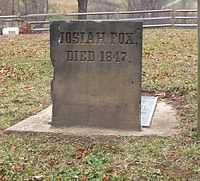Josiah Fox

Josiah Fox (1763–1847) was a British naval architect noted for his involvement in the design and construction of the first significant warships of the United States Navy.
Fox was born in Falmouth, Cornwall, Kingdom of Great Britain in 1763, and completed the apprenticeship at the Royal Dockyard, Plymouth, where he later served as a shipwright. In 1793 he traveled to the United States to survey timber resources and was there engaged to teach drafting to the sons of Jonathan Penrose, an American shipwright.
In 1794 he was employed by the US Navy as a draftsman working under Naval Constructor Joshua Humphreys, the designer of the first Navy frigates. Fox and Humphreys disagreed over design issues, the former believing that the designs were too long and had too sharp a bow, among other problems. This disagreement caused significant animosity between the two, with arguments over credit for the design continuing in the press as late as 1827.
In 1798, Fox was appointed Master Constructor of the frigate Chesapeake, 38, which was to be built in Norfolk. Fox apparently altered Humphreys’ design to his own liking, though this may have been partially the result of a timber shortage. The Chesapeake turned out to be less impressive a sailer than the other early frigates, had a reputation as an unlucky ship, and was captured by HMS Shannon in 1813.
In the first years of the 19th century, Fox was responsible for fitting out some of the gunboats that were the Republican Jefferson Administration’s unsuccessful attempt at creating a “Naval Militia.”
Fox died in 1847 and was buried in the cemetery near the Concord Hicksite Friends Meeting House, near Colerain.
Quaker family links

Fox, a Quaker, married Anne Miller of Philadelphia and had 10 children. He had been disowned from his Quaker Meeting for his involvement in the construction of warships, but was reinstated after the War of 1812. In 1814, Fox and his family settled in Colerain, Belmont County, Ohio, located in south-eastern Ohio.
Josiah Fox and two of his sons visited Cornwall in September 1833, to take possession of the property of his deceased brother, John. On Sunday 8 September, he met one of his relations, Barclay Fox, who recorded the meeting enthusiastically in his journal. On the next day, they met by chance at Falmouth Docks, which Josiah and his sons were inspecting.[1]
References
- ↑ Fox, Robert Barclay (1979). ed. by Raymond Brett, ed. Barclay Fox's journal. London: Bell and Hyman. ISBN 0-7135-1865-0.
and U.S. Fox, Robert Barclay (1979). ed. by Raymond Brett, ed. Barclay Fox's journal. Totowa, N.J.: Rowman & Littlefield. ISBN 0-8476-6187-3. Pages 55 and 56.
- Toll, Ian (2006). Six Frigates: the Epic History of the Founding of the U.S. Navy. New York: W. W. Norton. ISBN 0-393-05847-6.
- "Ferry Landing, Fall 2003". Martin Ferry Area Historical Society. Retrieved 4 December 2006.
|